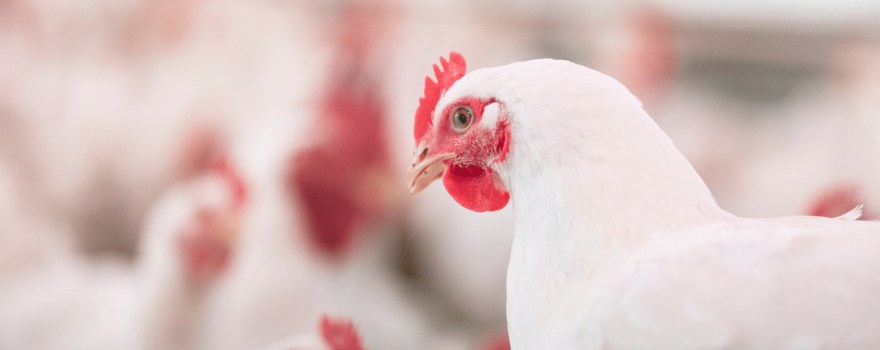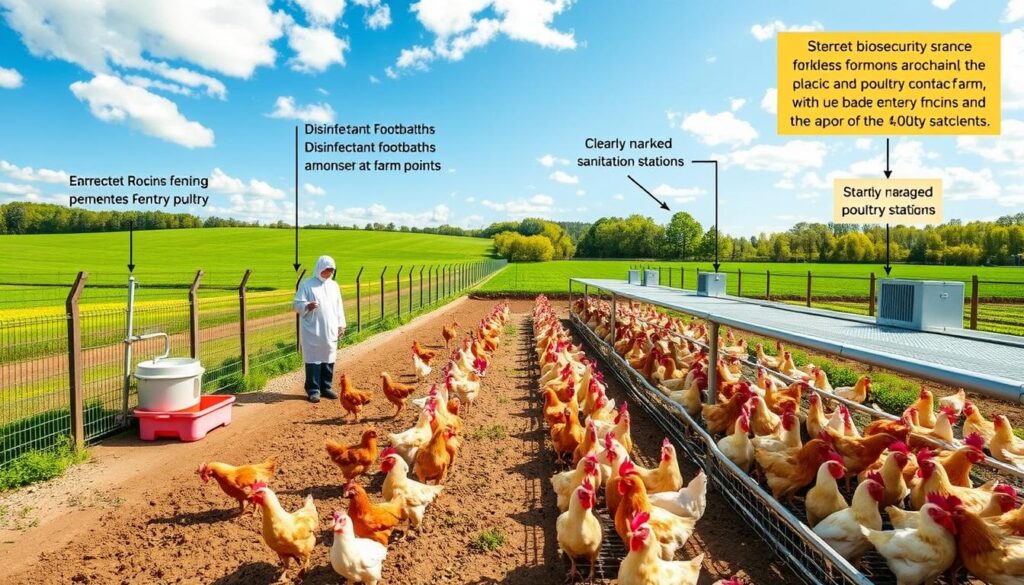
As a poultry farmer or producer, keeping your broiler chickens healthy is crucial. Avian influenza, or bird flu, is a major challenge. It’s a highly contagious viral disease that can severely impact your operation. This guide will help you understand how to identify, treat, and prevent avian influenza in your flock.
Key Takeaways
- Understand the different types of avian influenza, including highly pathogenic and low pathogenic strains.
- Learn to recognize the clinical signs and symptoms of avian influenza in broiler chickens.
- Discover effective diagnostic testing methods to identify the presence of the virus in your flock.
- Explore treatment options, including the use of antiviral medications and comprehensive biosecurity measures.
- Implement proven prevention strategies, such as vaccination programs, to safeguard your broiler chickens.
- Familiarize yourself with the regulatory guidelines and industry best practices for managing avian influenza outbreaks.
- Mitigate the impact of avian influenza on your poultry operation and maintain the productivity and profitability of your broiler flock.
Understanding Avian Influenza in Broiler Chickens
Avian influenza, also known as bird flu, is a viral disease that mainly hits poultry, like broiler chickens. It’s very contagious and can harm birds a lot. It also hurts the economy of those who raise broiler chickens.
What is Avian Influenza?
Avian influenza comes from a group of viruses that only affect birds. These viruses are split into two types: highly pathogenic avian influenza (HPAI) and low pathogenic avian influenza (LPAI).
Types of Avian Influenza: Highly and Low Pathogenic
HPAI viruses are very bad and can kill a lot of birds quickly. On the other hand, LPAI viruses cause milder symptoms and don’t kill as many birds. But, both can still hurt broiler chicken farms a lot.
| Characteristic | Highly Pathogenic Avian Influenza (HPAI) | Low Pathogenic Avian Influenza (LPAI) |
|---|---|---|
| Severity | Severe, often resulting in high mortality rates | Milder, with lower mortality rates |
| Spread | Highly contagious, spreads rapidly through poultry flocks | Less contagious, spreads more slowly |
| Impact on Broiler Chickens | Significant economic losses due to high mortality and culling | Reduced productivity and growth, but less severe economic impact |
Knowing the difference between HPAI and LPAI is key for broiler chicken farmers. It helps them spot, manage, and stop bird flu outbreaks in their flocks.
How to Identify and Treat Avian Influenza in Broiler Chickens
Spotting avian influenza early and treating it quickly is key to managing outbreaks on farms. As a poultry farmer, knowing the signs of how to identify avian influenza in broiler chickens is crucial. It’s also important to know how to treat it effectively.
Start by watching your flock for any odd behavior or physical changes. Signs of highly pathogenic avian influenza (HPAI) include less feed and water, being very tired, fewer eggs, blue skin, and sudden death. Low pathogenic avian influenza (LPAI) might show milder symptoms like breathing problems, diarrhea, and fewer eggs.
If you think you have an outbreak, call your vet or local animal health right away. They can help with tests and tell you how to treat it. You might use medicines like oseltamivir or zanamivir. Also, make sure to follow strict biosecurity rules to stop the disease from spreading.
| Identification | Treatment |
|---|---|
|
|
By being proactive in identifying and treating avian influenza in broiler chickens, farmers can reduce its impact. This helps keep their flocks healthy and productive.
Avian Influenza Symptoms in Broiler Chickens
Avian influenza, or “bird flu,” is a big worry for broiler chicken farmers. It’s important to know the signs of this disease early. This helps in managing it well. Each type of avian influenza shows different symptoms that farmers need to watch for.
Clinical Signs of Highly Pathogenic Avian Influenza
Highly pathogenic avian influenza (HPAI) is a serious disease. It can cause many birds to die quickly. Look out for these signs:
- Sudden death with no prior signs
- Decreased feed and water consumption
- Lethargy and depression
- Cyanosis (bluish discoloration of the skin and wattles)
- Diarrhea and respiratory distress
Clinical Signs of Low Pathogenic Avian Influenza
Low pathogenic avian influenza (LPAI) has milder symptoms. These can be easy to miss. Farmers should watch for:
- Reduced egg production
- Mild respiratory signs like nasal discharge and coughing
- Slight decrease in feed and water intake
- Mild diarrhea
Spotting these avian influenza symptoms in broiler chickens early is key. It helps in taking the right steps to protect the flock and the industry.
Diagnostic Testing for Avian Influenza
Quick and accurate testing is key to managing avian influenza in broiler chicken flocks. Several methods are used to find the virus and help treat and control outbreaks on poultry farms.
The real-time reverse transcription-polymerase chain reaction (rRT-PCR) test is a main tool for avian influenza diagnosis. It quickly spots the virus’s genetic material. Virus isolation in chicken eggs is also a top method for confirming the virus’s presence.
Serological tests, like the hemagglutination inhibition (HI) assay and enzyme-linked immunosorbent assay (ELISA), check for antibodies. These antibodies are made by the chicken’s immune system in response to the virus. These tests help tell if a chicken is currently or was previously infected, giving important information.
| Diagnostic Test | Description | Key Benefits |
|---|---|---|
| rRT-PCR | Molecular assay that detects viral genetic material | Rapid, sensitive, and specific detection of influenza virus |
| Virus Isolation | Inoculation of embryonated chicken eggs to isolate the virus | Considered the gold standard for confirming the presence of the virus |
| Serological Tests (HI, ELISA) | Detect antibodies produced by the chicken’s immune system | Differentiate between current and past infections, provide epidemiological data |
Choosing and using these tests should match each poultry farm‘s needs. It’s important to work with vet experts and follow guidelines. This ensures avian influenza in broiler chicken flocks is found quickly and accurately.

Treatment and Management of Avian Influenza Outbreaks
Managing avian influenza in broiler chickens needs a detailed plan. This plan includes using antiviral drugs and strong biosecurity steps.
Antiviral Medications for Avian Influenza
Antiviral drugs are key in treating avian influenza in chickens. They stop the virus from spreading, reducing symptoms and stopping the disease. Oseltamivir (Tamiflu) and zanamivir (Relenza) are common drugs used.
Biosecurity Measures for Poultry Farms
Strong biosecurity is vital to fight avian influenza and stop it from spreading. Important steps include:
- Limiting who can enter the farm and making visitors follow strict cleaning rules
- Cleaning all equipment, vehicles, and areas regularly
- Keeping sick birds separate and disposing of them properly
- Keeping everything clean and monitoring birds for illness
Using antiviral drugs and good biosecurity together helps poultry farmers manage outbreaks. This way, they can protect their chicken operations.
| Antiviral Medication | Mechanism of Action | Effectiveness Against Avian Influenza |
|---|---|---|
| Oseltamivir (Tamiflu) | Inhibits the neuraminidase enzyme, preventing the release of new virus particles | Effective against both highly pathogenic and low pathogenic avian influenza strains |
| Zanamivir (Relenza) | Binds to the active site of the neuraminidase enzyme, preventing viral replication | Effective against a wide range of avian influenza subtypes |
Avian Influenza Prevention Strategies
Keeping broiler chickens safe from avian influenza is key to their health and success. To protect poultry farms, it’s important to use vaccination and biosecurity measures. These steps help prevent the spread of this deadly disease.
Vaccination Programs for Broiler Chickens
Vaccination is a major part of keeping broiler chickens safe. Vaccines boost their immune system, making them less likely to get sick. It’s important for farmers to work with vets to create the best vaccination plans for their farms.
Here’s what vaccination for broiler chickens usually involves:
- Choosing the right vaccine based on local disease risks
- Setting up a vaccination schedule that fits the farm’s needs
- Administering vaccines correctly to ensure they work well
- Checking the birds’ immune levels to see if the vaccines are working
With a strong vaccination program, farmers can lower the chance of avian influenza outbreaks. This keeps their chickens healthy and productive.
Biosecurity Measures for Poultry Farms
Besides vaccination, good biosecurity is crucial to stop avian influenza from getting into farms. This includes:
- Having strict rules for who and what comes onto the farm
- Keeping the farm and its areas clean and disinfected
- Limiting the movement of people, birds, and things to prevent disease spread
- Watching the flock closely for any signs of illness
- Having plans ready in case of an outbreak
By using vaccines and strong biosecurity, farmers can greatly lower the risk of avian influenza. This keeps their chickens healthy and productive.

Impact of Avian Influenza on Poultry Industry
The outbreak of avian influenza, also known as bird flu, can severely harm the poultry industry. This disease is highly contagious and affects broiler chickens’ health. It also causes big economic and trade problems for the whole poultry sector.
The impact of avian influenza on poultry industry is wide-ranging. When outbreaks happen, infected flocks are often culled. This greatly reduces poultry production and supply. It can also make prices for consumers go up, causing problems for both producers and buyers.
Moreover, the fear of contaminated poultry can lower demand. This makes the economic hit on the industry even worse.
The broiler chicken diseases from avian influenza can also mess with international trade. Countries might stop importing poultry from affected areas. This can hurt poultry farmers and processors’ finances by cutting off export markets.
Good poultry farm management is key to fighting avian influenza. This includes strict biosecurity and watching for diseases closely. By doing these things, farmers can protect their birds and lessen the impact on the whole industry.
“The financial and logistical burdens from avian influenza outbreaks can be very hard on poultry producers and the whole supply chain. It’s important to stay alert and use strong preventive steps to keep the industry strong and stable.”
As the poultry industry deals with bird flu challenges, it’s vital for everyone to work together. Producers, policymakers, and industry leaders need to create strong plans to handle this disease. This will help keep the sector safe and sustainable for the future.
Regulations and Guidelines for Avian Influenza Control
Poultry producers in the United States must follow strict rules to manage avian influenza outbreaks. These rules help stop the virus from spreading. They also protect the health of poultry and the poultry industry.
It’s important to report any suspected or confirmed cases of avian influenza quickly. This includes telling the USDA and APHIS. Fast reporting helps in taking action fast, like restricting movement and quarantining flocks.
Biosecurity is key for poultry farms. Producers must follow strict biosecurity rules. This includes controlling who enters poultry houses and keeping everything clean. These steps help prevent the virus from spreading.